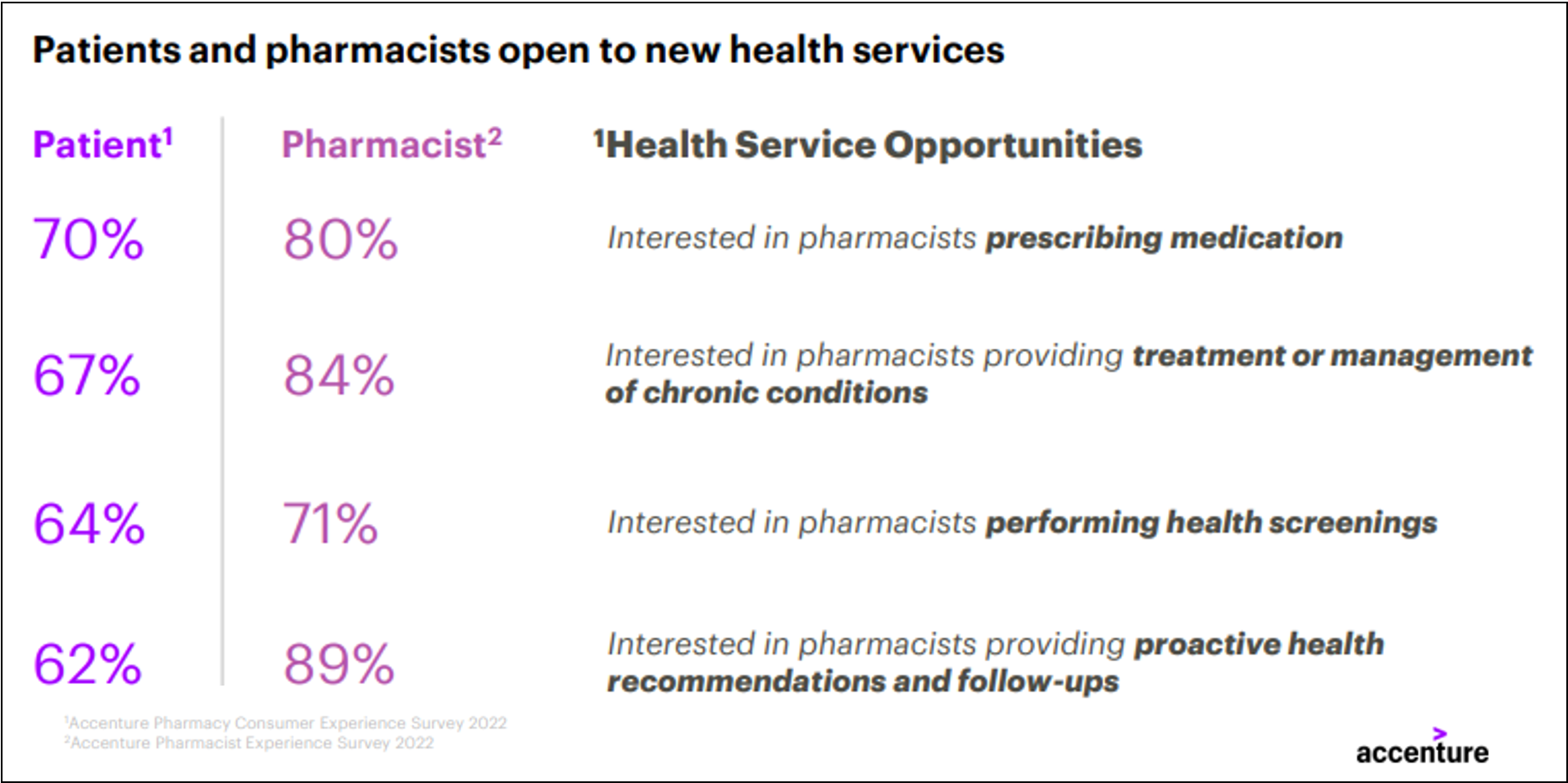Article
Future Pharmacy Experience: How Pharmacists Can Better Meet Patient Needs
Author(s):
Pharmacies need to differentiate themselves through faster and cheaper care, while delivering health outcomes across the patient journey.
For years, pharmacies have been the last stop in the world of health care, delivering medication and services after a patient is diagnosed with an illness. During the COVID-19 pandemic, pharmacists served on the frontlines, changing patient perceptions around pharmacies’ ability to meet a broader set of health care needs.
However, margin pressures from both revenue and cost have forced pharmacies to focus on efficiency rather than empathy—relying on volume-based models, shifting focus to time, count, and quantity of prescriptions in place of patient service. This transactional nature has left pharmacies susceptible to competition with patients prone to switch to cheaper or more convenient locations.
To secure and maintain patient relationships, pharmacies need to differentiate themselves through faster and cheaper care, while delivering health outcomes across the patient health journey. While most people today still choose their pharmacy primarily based on affordability and convenience, new research from Accenture shows most patients (86%) are or would be interested in a more meaningful relationship with their pharmacist and receiving care and guidance on their health and wellbeing.*
With pharmacy talent currently focused on total volume of prescriptions, patients have looked for this value elsewhere, leaving a significant source of potential revenue for pharmacies on the table.
The reality is that pharmacists are among the most accessible holistic health care providers. On average, patients interact with pharmacists up to 10 times more often than their primary care physician.
Our research reveals a strong desire among both patients and pharmacists for pharmacies to provide more health care options, including prescribing medication, treating, or managing chronic conditions, performing health screenings, and offering proactive health recommendations and follow-ups (Figure 1).

Pharmacists have the desire, expertise, and access to expand the role they play in care delivery, but current expectations and systems force them to work beneath their capabilities. The focus on volume has led pharmacies to create incentives aligned to efficiency, leaving little time for pharmacists to support patients’ foundational human needs.
Meanwhile, these transactional incentives lead to pharmacist burnout and talent shortages. Pharmacists report overwhelming emotional exhaustion from pressures to move quickly, heavy workloads, and lack of staff. In fact, our research found more than 1 in 3 pharmacists are likely to leave their position in the next 2 years.
Elevating the role of the pharmacist will not only benefit patients, but also give pharmacists the opportunity to build a more fulfilling career. Integrating pharmacists into the broader care delivery team could alleviate the growing pressure of clinician shortages across the health care industry as well, improving access, experience, and outcomes. Moreover, this an opportunity for pharmacies to shift away from focusing on total volume of prescriptions toward expanding the scope of services that create new sources of revenue.
We have identified 3 key actions organizations can take to realize pharmacists’ full potential and drive value by reducing costs, creating new revenue streams, and delivering proactive care:
1. Operate with Empathy
Rebalance investments to allow space for pharmacists to work at the top of their license and eliminate low value tasks through reallocation, automation, AI, or robotic support. Pharmacies can continue to meet patients’ cost and access priorities by leaning into new digital products and services that deliver on convenience while freeing up the pharmacist to focus attention on patient relationships, clinical services, or medication expertise that better meet patient health outcomes.
This will also drive cost savings from task automation and reallocation of most the valuable talent resources.
2. Move to the Front Line of Care
Elevate the role of the pharmacist as a health care provider to support a broader swath of patient needs. Pharmacists can supplement primary care service to treat and prescribe, which expand profitability beyond volume and make pharmacies the most accessible destination for care.
To successfully transition to the front line of care, pharmacies will need to explore differentiated reimbursement models alongside refreshed pharmacist incentive structures and talent models that align with expanded care. Additionally, pharmacists may need training necessary to offer the care services that align best to their expertise and the broader health ecosystem.
3. Become a Proactive Partner on Care Teams
Proximity to the patient and medical expertise positions pharmacists to join the ranks of the patient care team. In partnership with other care providers, pharmacies can build trusted relationships and generate insights across health dimensions to deliver on patients’ health outcomes.
The pharmacist should expect to go far beyond the administration of treatment plans or even the individual performance of new health services, beginning to deliver ongoing care focused on uncovering and treating the root cause of disease, preventative medicine, and holistic support across the care journey. This will also require integration with local health plans and health systems to enable pharmacies to provide care partnerships within a local community.
Now is the time for pharmacies to respond to this increasing interest by exploring how to expand the scope of their services and shift pharmacists’ focus to patient relationships, clinical services, or medication expertise. The organizations that jump on this opportunity will create a better experience for patients and pharmacists, while reducing costs and creating incremental revenue sources to drive their business.
*Accenture surveyed more than 1600 North American adult pharmacy consumers to understand their experience and preferences with pharmacy services and pharmacists. Accenture also surveyed more than 430 pharmacists in patient-facing roles across the United States and Canada to understand their work experience and satisfaction, as well as preferences for the future role of pharmacists in the health ecosystem. The research was conducted in November 2022.
About the Authors
Tyler Slovick and Asher Perzigian, managing directors, Accenture Health Strategy & Consulting.
Newsletter
Stay informed on drug updates, treatment guidelines, and pharmacy practice trends—subscribe to Pharmacy Times for weekly clinical insights.






